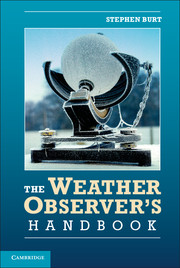Book contents
- Frontmatter
- Contents
- Acknowledgements
- Abbreviations, footnotes and references
- Part One The basics
- 1 Why measure the weather?
- 2 Choosing a weather station
- 3 Buying a weather station
- 4 Site and exposure – the basics
- Part Two Measuring the weather
- Part Three Making the most of your observations
- Appendix 1 Metrology and meteorology: The basics of instrument theory
- Appendix 2 Useful functions
- Appendix 3 Unit conversions
- Appendix 4 Useful sources
- Index
- References
4 - Site and exposure – the basics
Published online by Cambridge University Press: 05 July 2012
- Frontmatter
- Contents
- Acknowledgements
- Abbreviations, footnotes and references
- Part One The basics
- 1 Why measure the weather?
- 2 Choosing a weather station
- 3 Buying a weather station
- 4 Site and exposure – the basics
- Part Two Measuring the weather
- Part Three Making the most of your observations
- Appendix 1 Metrology and meteorology: The basics of instrument theory
- Appendix 2 Useful functions
- Appendix 3 Unit conversions
- Appendix 4 Useful sources
- Index
- References
Summary
There’s an oft-repeated saying that real-estate agents will tell youof the three important factors when it comes to property: location,location, location. When it comes to setting up instruments tomeasure the weather, the refrain could be similar: exposure,exposure, exposure.
It is certainly true that a well-exposed budget AWS will give morerepresentative and reliable statistics than a poorly exposedtop-of-the-range AWS costing as much as a small car. However, a garden thesize of New York’s Central Park is not a prerequisite to makingworthwhile weather observations, because by taking some care in siting yoursensors and following the advice in this chapter, good results can beobtained from all but the most sheltered locations.
Firstly, what is meant by site and exposure? Thetwo terms are often used synonymously, but in this booksite is normally used to refer to ‘the area orenclosure where the instruments are exposed’, whileexposure refers to ‘the manner in which thesensor or sensor housing is exposed to the weather element it ismeasuring’.
Information
- Type
- Chapter
- Information
- The Weather Observer's Handbook , pp. 76 - 86Publisher: Cambridge University PressPrint publication year: 2012
